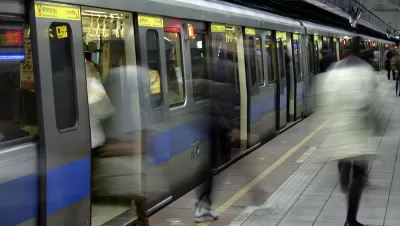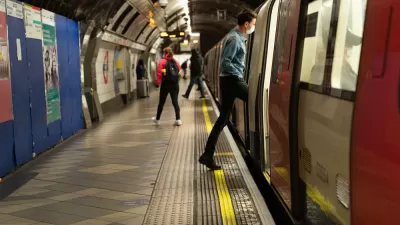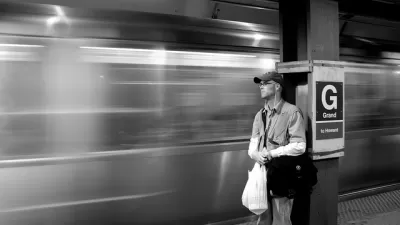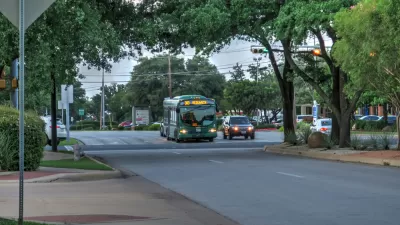In response to the news that transit ridership reached an all-time high in 2013, commentators of all stripes sought to deny or minimize the news. But such arguments are themselves flawed.

After the American Public Transit Association announced that public transit ridership reached an all-time high of over 10 billion riders, a variety of commentators sought to minimize the importance of this news, using a wide variety of arguments. Transit critics seek to deny news of ridership increases to encourage politicians to reduce transit service, while transit supporters do the same to prevent their allies from becoming complacent. But all of these arguments share one thing in common: a claim that whatever transit agencies do right, it just isn't good enough. To name a few examples:
1. The "Only in New York" Strategy: Transit critic Randall O'Toole chose a strategy of total denial, claiming that all of the increase happened in New York City. However, a look at the APTA ridership page shows that bus ridership rose in 20 of the 37 largest bus systems, heavy rail ridership rose in 8 out of 15 systems, and light rail ridership rose in 17 out of 27 transit systems. On balance, ridership seems to have risen more often than not.
2. The "Not As Fast As Population" Strategy: A Washington Post op-ed by several professors points out that per capita ridership is lower than in 2008. However, transit ridership reached another all-time high in 2008 due to exploding gas prices, so comparing 2008 and 2013 shows only that per capita ridership is not at an all-time high. One might as well claim that the Democratic Party is in terminal decline because the current President did not carry 48 out of 50 states (as Franklin Roosevelt did in 1936).
But if one uses other years as a starting point, one sees different results: since 2010, ridership has increased by 4.6 percent, while population has increased by less than 3 percent. And since 1995, ridership increased by 37 percent while population increased by 20 percent. Admittedly, this may not seem like an earth-shaking gain to some: but after decades in which transit use declined in absolute terms, and after a few more decades in which transit growth lagged behind population growth, the current trend might seem newsworthy.
3. The "Most People Still Drive" Strategy: Another common strategy, often accompanied by adroit use of bar charts, is to point out that transit is minuscule percent X of the U.S. transportation market. This argument has the advantage of being consistently factually correct: no matter how much transit use rises, it will never be good enough until the far-off (if not nonexistent) day when public transit use reaches World War II levels. Transit use could quadruple, and pundits could still say "That's all very well and good, but only 15 or 20 percent of commuters use transit, so shut up."
So who's right? The transit pessimists are right, I suppose, in pointing out that most Americans still drive to work. But the transit boosters are right in pointing out that transit use is not only rising, but rising to a greater extent than in past decades.

Alabama: Trump Terminates Settlements for Black Communities Harmed By Raw Sewage
Trump deemed the landmark civil rights agreement “illegal DEI and environmental justice policy.”

Study: Maui’s Plan to Convert Vacation Rentals to Long-Term Housing Could Cause Nearly $1 Billion Economic Loss
The plan would reduce visitor accommodation by 25% resulting in 1,900 jobs lost.

Planetizen Federal Action Tracker
A weekly monitor of how Trump’s orders and actions are impacting planners and planning in America.

Wind Energy on the Rise Despite Federal Policy Reversal
The Trump administration is revoking federal support for renewable energy, but demand for new projects continues unabated.

Passengers Flock to Caltrain After Electrification
The new electric trains are running faster and more reliably, leading to strong ridership growth on the Bay Area rail system.

Texas Churches Rally Behind ‘Yes in God’s Back Yard’ Legislation
Religious leaders want the state to reduce zoning regulations to streamline leasing church-owned land to housing developers.
Urban Design for Planners 1: Software Tools
This six-course series explores essential urban design concepts using open source software and equips planners with the tools they need to participate fully in the urban design process.
Planning for Universal Design
Learn the tools for implementing Universal Design in planning regulations.
Caltrans
Smith Gee Studio
Institute for Housing and Urban Development Studies (IHS)
City of Grandview
Harvard GSD Executive Education
Toledo-Lucas County Plan Commissions
Salt Lake City
NYU Wagner Graduate School of Public Service






























